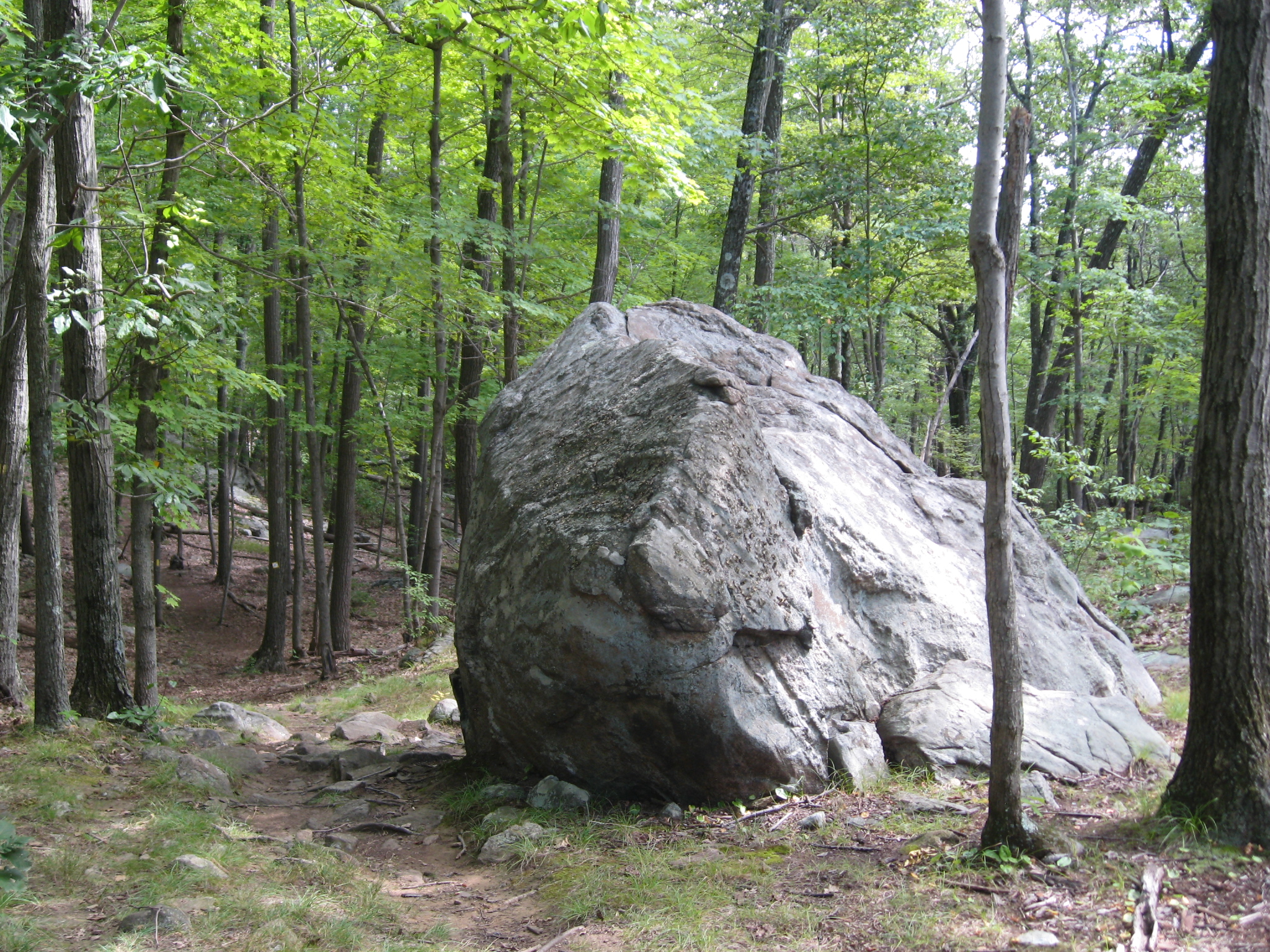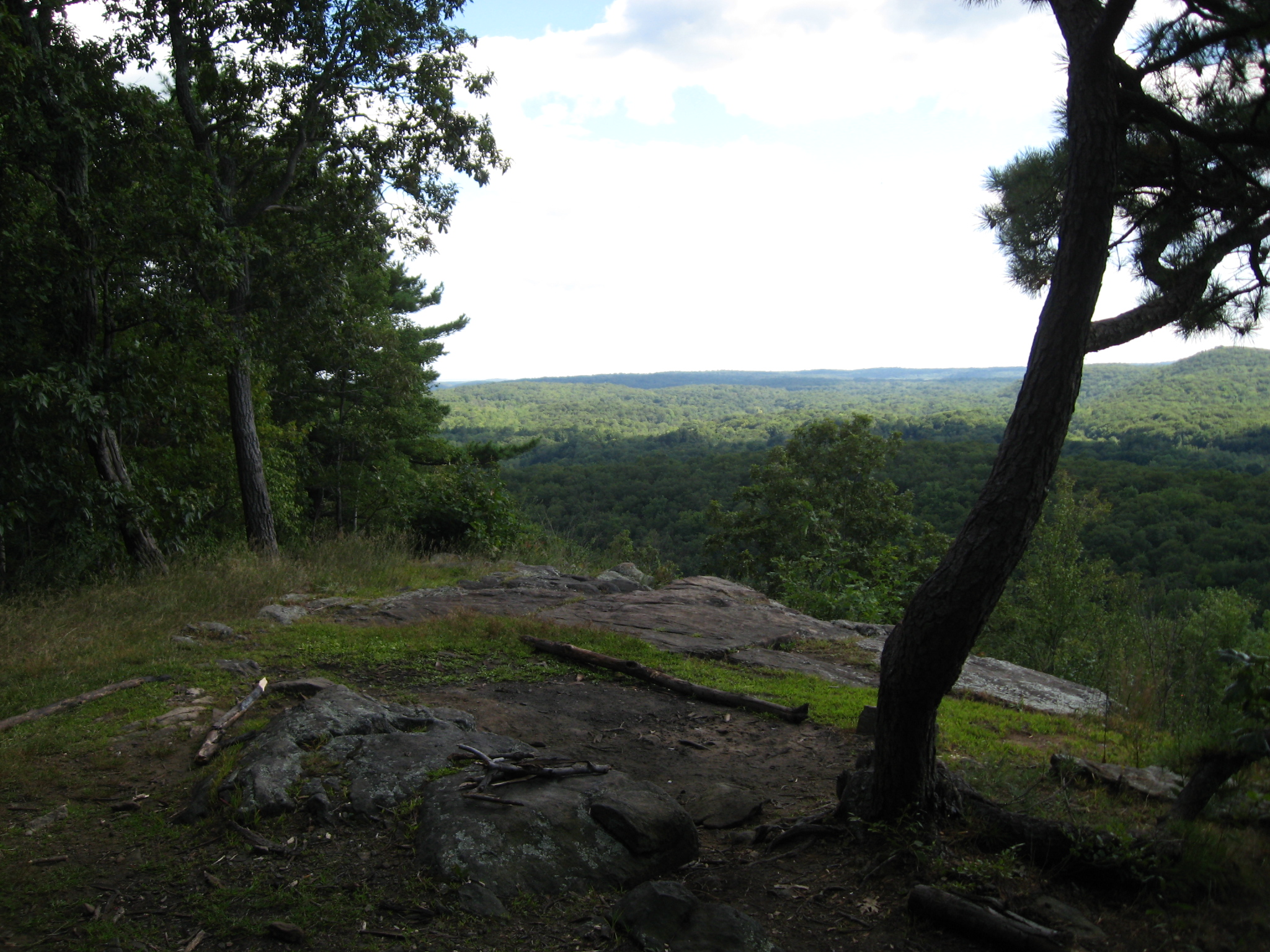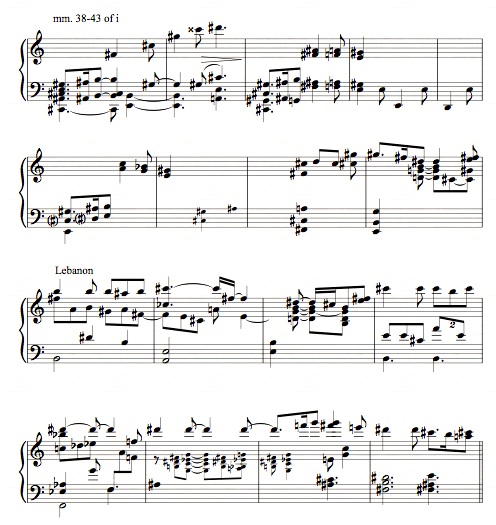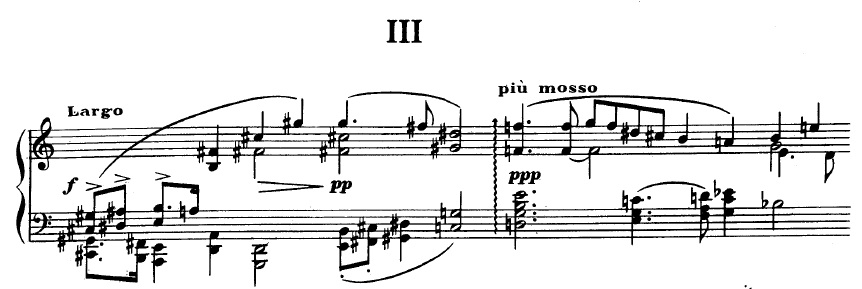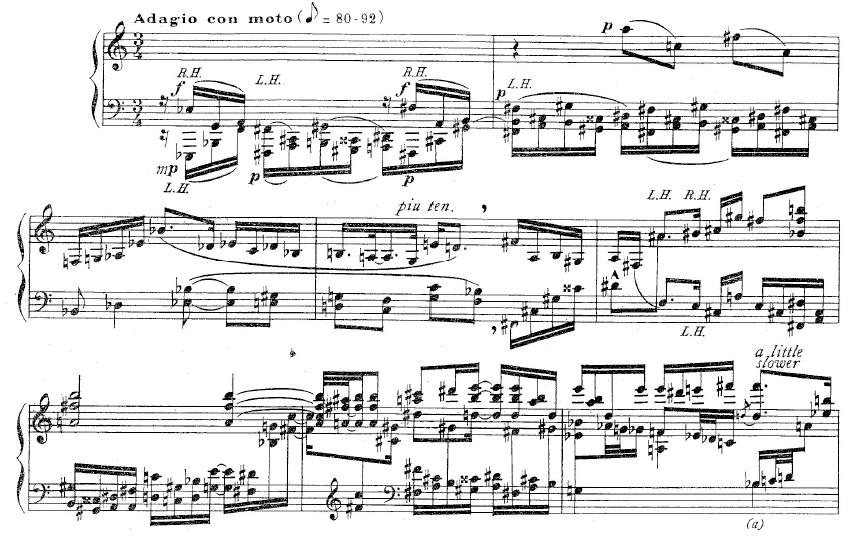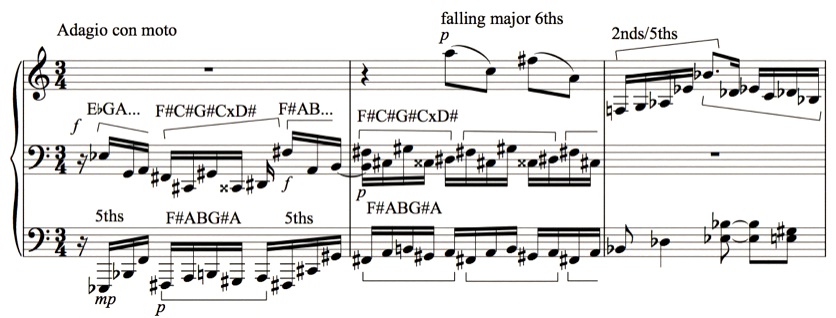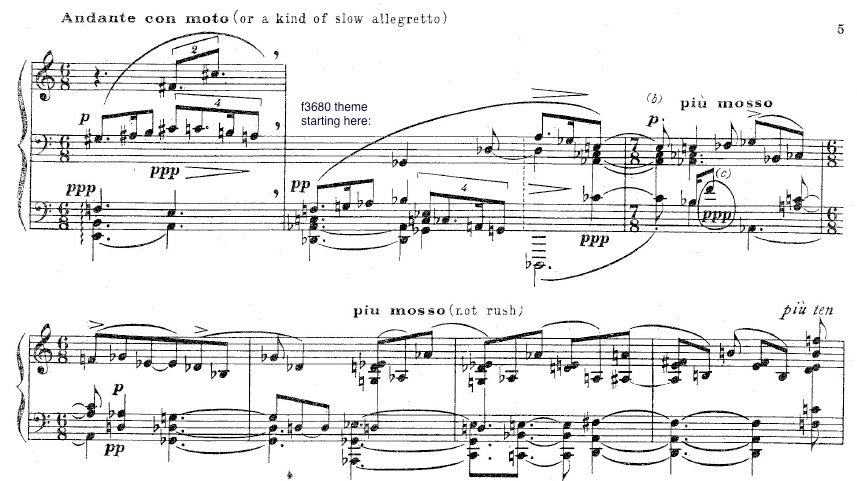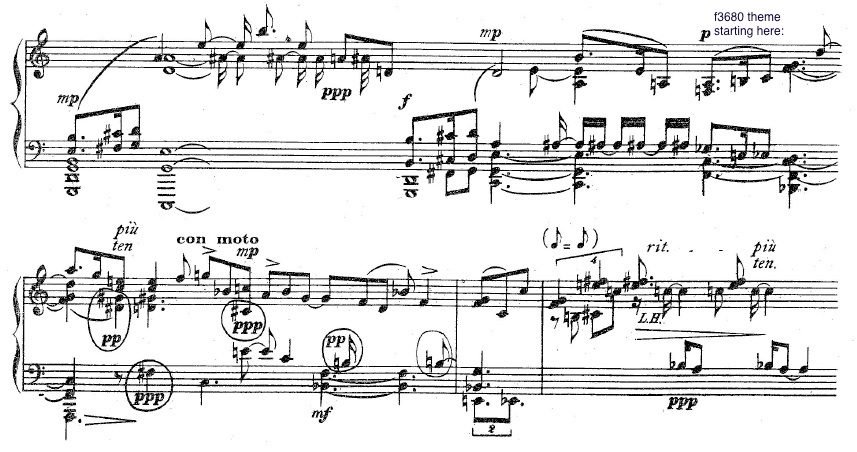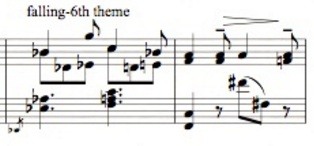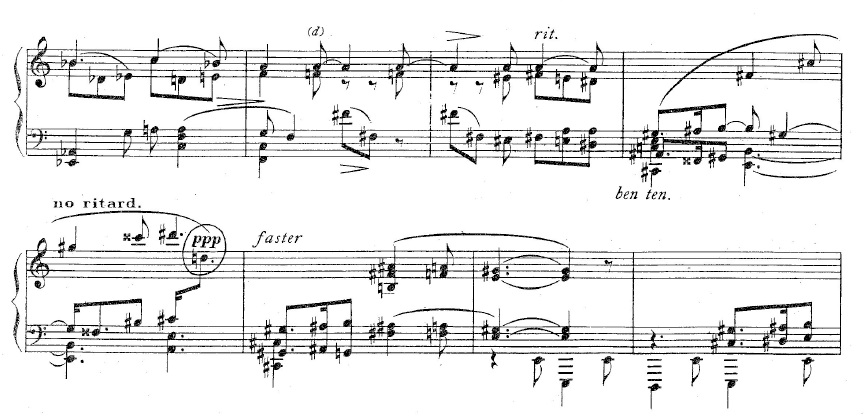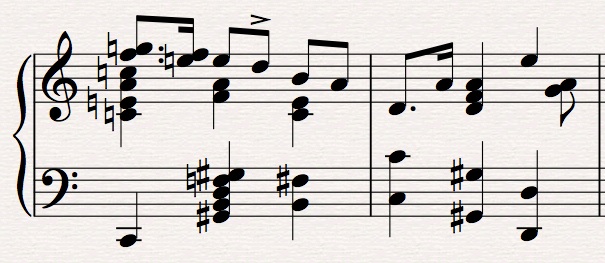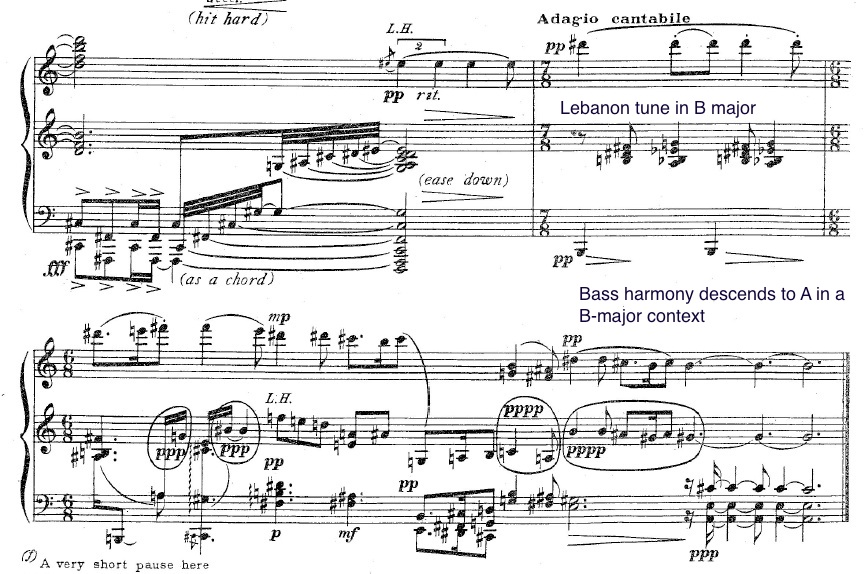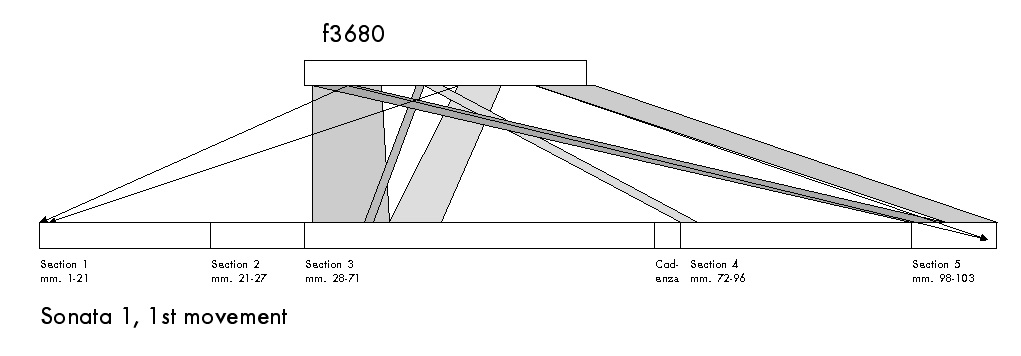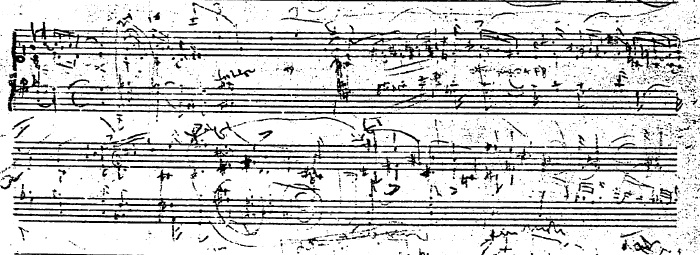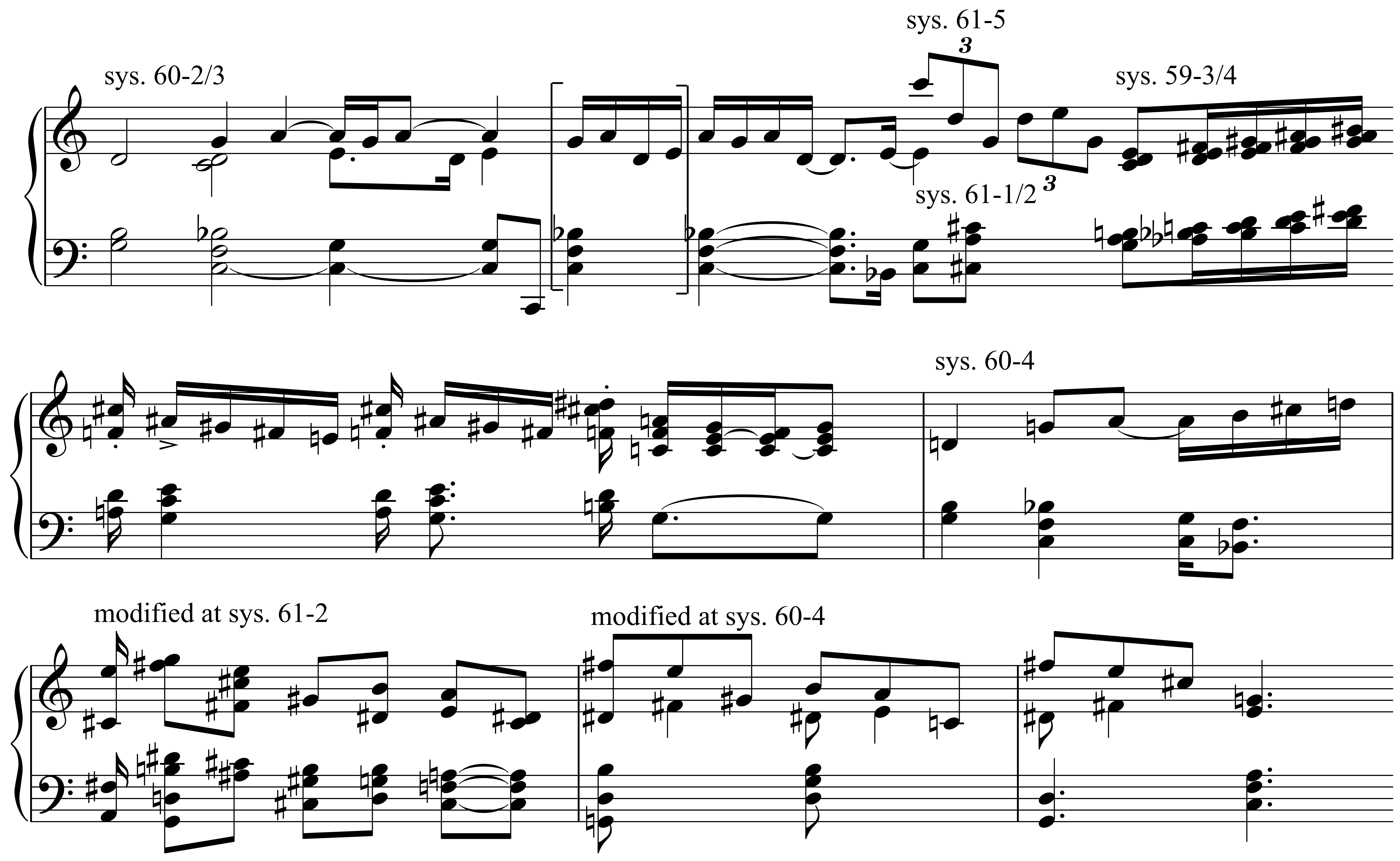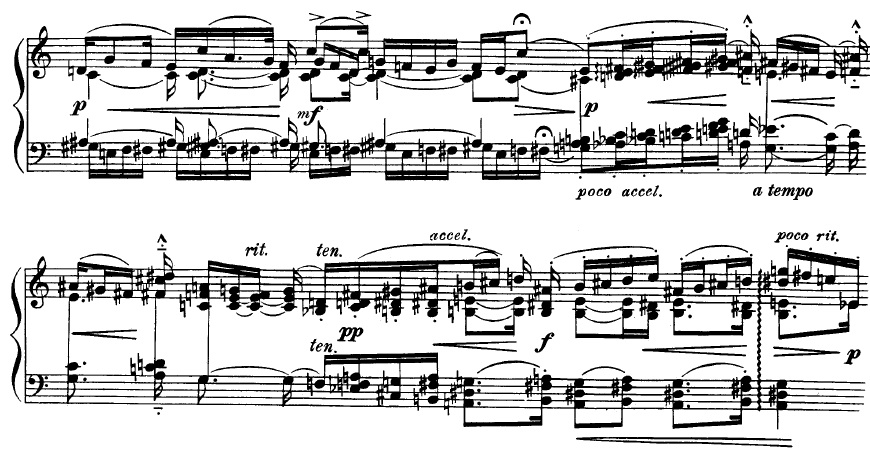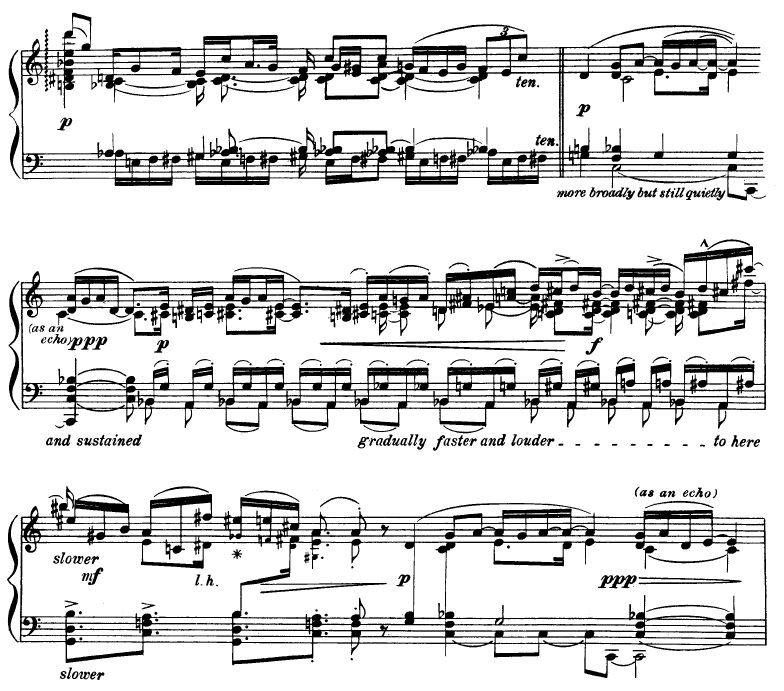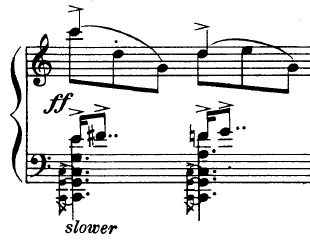How Ives Composed: The Geiringer Lecture By Kyle Gann
Delivered at the University of Santa Barbara, November 4, 2015
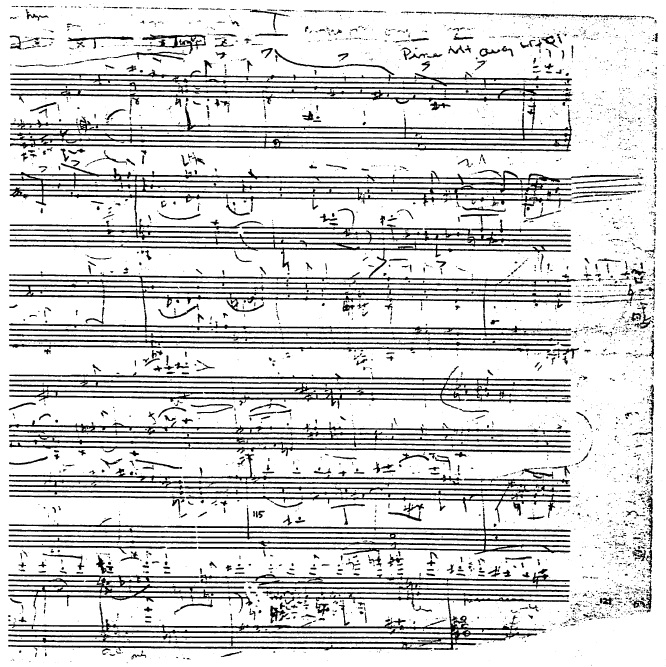
What you're looking at is a page of a manuscript written by Charles Ives. It is identified in the Yale library collection of Ives papers as f3680. There are more than 8000 pages of Ives manuscripts housed at Yale, identified by "f" numbers, standing for copy-flow, and this is one of the most fascinating ones I've found. If you look closely in the upper right-hand corner, you can see that it is identified by place and date: it says "Pine Mountain, August 4, '01," meaning 1901. Some of the dates on Ives's manuscripts have been challenged for one reason or another, but I have not see this one challenged.
Pine Mountain is a beautiful, wooded, and rocky wilderness just a few miles southwest of Danbury, Connecticut, where Ives grew up, and in 1901, his family actually owned some of the land on it.
Today this area has been long since taken over by the state, and there is a long hiking trail on it that has been named the Ives Trail. This spot boasts one of the most panoramic views in the state of Connecticut, and on this very spot, in the first years of the 20th century, Charles Ives and his brother Moss built a cabin.
(You can't clearly tell from the photo, but there's a 40- or 50-foot drop just on the other side of this ledge.) Ives was already working as a low-level grub in the New York insurance business, but he and Moss used to love to spend their weekends out here at Pine Mountain. The cabin fell down, or was torn down, many decades ago, but there is today a plaque marking the spot in Ives's honor. And according to Ives, this manuscript was written here. Keep in mind that in August of 1901 Ives was only 26; this is not the bearded and garrulous old Ives that generally marks our image of him, nor the weakened and frail diabetic, but a vigorous young man who loved to camp in the wilderness, at the beginning of his insurance career, not yet married, no sign yet of any illness to come.
Here is my transcription of f3680, which I made going over the actual manuscript carefully with a magnifying glass:
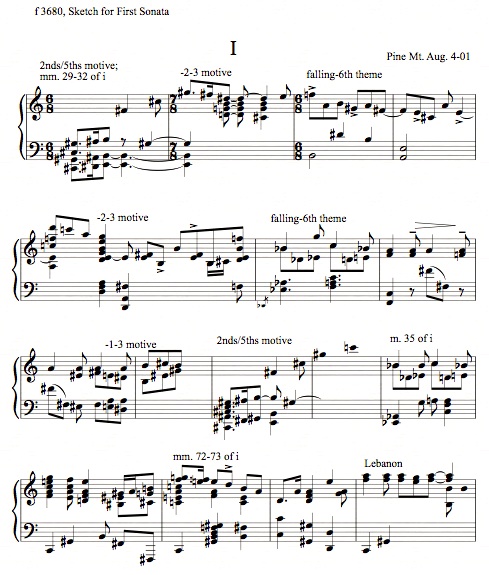
Since the actual manuscript is clearer to read than the copy, I feel fairly confident about the transcription's accuracy. There is a Roman-numeral I at the top of the page, because this is what would become the first movement of Ives's First Piano Sonata. In later lists of works Ives described the First Sonata as having been written between 1901 and 1909, which is already an extraordinarily long gestation period for a piano sonata; it spans from his years as an active church organist to his abandonment of professional music, the government investigation of the insurance business that enabled Ives to move quickly up the ladder, his courtship of and marriage to his wife Harmony, and the beginning of the rapid rise of his wealth. And yet we know, and he at some point admitted, that the last movement, which is in a somewhat different style than the rest, was rewritten no earlier than 1917, during World War I, so that the First Sonata was actually composed contemporaneously with its more famous sibling, the Concord Sonata. It took Ives at least sixteen years to bring the First Sonata into its final form, and possibly as many as eighteen. We will have reason to keep this in mind.
Here is the audio of the transcription of f3680 (MIDI version, forgive me). It is 33 measures long, and you'll notice there are gaps in the musical continuity. There are moments at which he sketches in the harmony and leaves the melody for later. Some of the continuity doesn't make much sense.
Taken as a continuous piece of music, it's pretty odd, isn't it? Yet those of you familiar with the completed First Sonata will recognize several passages. The piece opens with a rising motive leading through a series of fifths, and after the first gesture the melody quickly loses any sense of focus. A hymn tune called Lebanon makes a brief appearance in the middle, and then comes back at the end, trailing away before the final cadence. If someone played me this piece without any context, I think I would have guessed it was by an American composer in a mild, middle-of-the-road, neoclassic style from the 1940s or '50s. The sketch looks, to my composer's eye, unpromising and uninspired, and yet even so the fact that Ives wrote a sketch in 1901 that I would have attributed to the 1940s is remarkable.
I want now to compare this opening sketch with the First Sonata as it was finally performed in 1949 and published in 1950. First of all, the beginning of f3680 so much resembles the opening of the sonata's third movement that when I first ran across it, I was convinced that I was looking at a sketch of the third movement instead, and that perhaps Ives had changed his mind about the movement order.
The tempo and meter are slower and more stately, but up to the F the contour is nearly exact.
Let's look now at the opening of the actual first movement, which is completely different.
The entire first page is pervaded by two five-note ostinatos in 16th-notes. One of them uses the pitches F#-A-B-G#-A, which suggests F# minor; the other is a segment of a circle of fifths with a half-step thrown in, F#-C#-G#-Cx-D#.
If we look back at page f3680, though, we find that one of the variations of the opening motive (at mm. 17-18) leads to a line of fifths with a half-step, F#-C#-G#-Cx-D#, and this is the motive from which, with octave displacements, Ives derived his circle-of-fifths ostinato. The other ostinato we find in m. 3, within the opening melody (where this line appears in the finished sonata, the initial F-natural is altered to F#):
And so the melodic material of the whole first page of the sonata has as its background a pair of pitch rows, fused together contrapuntally, that come from different places in the original sketch.
The opening two sections of the finished sonata movement don't contain material that corresponds closely to f3680, but they do develop, independently, three motives that make up Ives's opening 1901 melody: the two rising steps leading to a series of rising fifths; the falling major second followed by a falling minor third; and what I call the "falling 6th" theme, which leaps down and circles into a repetitive stasis. And then, looking through the completed sonata, we find, at mm. 29-43, a passage that looks closely related to f3680. The passage closely follows the first eight measures of the sketch, transposed, but right down to the detail of having the second measure in 7/8 meter (even though the bar lines are moved), and then jumping to the continuation of the opening motive that gave us the five-note opening motto.
Piano Sonata 1, mm. 29-33:
Moreover, this opening theme in the first eight measures of the sketch appears again in its entirety, although transposed, at mm. 98-99, the only material in this sonata movement to be recapitulated:
Piano Sonata 1, mm. 98-99 (recapitulation):
Jumping to the middle of the sketch, we find two passages that continue this in the finished sonata:
Ms. f3680, mm. 6-7:
Ms. f3680, mm. 17-20:
Piano Sonata 1, mm. 98-99 (recapitulation):
Note the loping bass line on E that grows from both of these last two passages at the end. Out of our 33-measure sketch, then, 16 of the measures (mm. 1-8, 10-12, and 17-21) correspond to material here in the middle of the first movement.
Meanwhile, in mm. 14 and 15 of the sketch, we have a brief two-measure pattern:
that will be vastly expanded into the fourth section of the movement, the Allegro risoluto of mm. 72-97:
You can see how closely those two measures (in the middle) correspond to what Ives eventually wrote as the opening measures of that climactic section, even though material preceding and following those two measures is completely discontinuous with it. Notice the bass line with its augmented fifth/minor third/minor second pattern, which runs through several passages of the sonata as an important ostinato.
At m. 16 in the sketch Ives places a one-measure phrase from the hymn Lebanon:
and in the final eight measures he quotes almost the entire tune. In the finished sonata he expands this passage and adds some interruptions, but you can see here how closely he stuck to his original version of how this hymn was going to be harmonized, including the falling-6th theme as a countermelody.
And lastly, you can see that twice in the sketch, near the beginning (mm. 3-4) and near the end (mm. 26-27), Ives moves the harmony in the bass down to A in a B-major context; and in the final notes of the finished movement he makes a surprise movement down to A major as the melody finishes in B, much like the surprise move from Bb to Ab at the beginning of the Alcotts movement of the Concord.
So now I'm going to recap what happened to this initial one-page sketch in the years between 1901 and 1909, on its way to becoming the first movement of the First Sonata. (And in case you're wondering about the possible continuation of f3680, f3681 contains sketches that are much closer to the opening measures of the sonata as it finally appeared.) This architectural-looking chart shows where material from the 33-measure sketch ended up in the 103-measure sonata movement.
First, Ives fashioned an introduction to the movement by combining two motives found in the sketch but at different places: one found at m. 3, the other at mm. 17-18.
Ives took apart his opening melody in f3680 into three motives and developed them individually in the sonata's first 27 measures.
Most of the first half of f3680, including mm. 1-8, 10-12, and 17-21, ends up as mm. 29-43, the first half of the third large section of the sonata movement, with some reordering of the measures.
Measures 14-15 of the sketch become the opening of the fourth section of the movement, and are greatly developed and extended.
The entire opening theme of f3860 appears twice in its original form, transposed to two different pitch levels but quite recognizable, at mm. 29-33 and just before the denouement at mm. 98-99. Again, this is the only material from the first half of the sonata repeated in the second half, in the manner of a traditional recapitulation.
The almost-complete quotation of Lebanon at the end of the sketch appears, extended and interrupted, at the end of the sonata movement.
Finally, the root movement from B to A that appears in the sketch at mm. 3-4 and 26-27 is delayed and saved until the very end of the movement, as its final surprise ending.
What fascinates me about this process is how much commitment Ives showed, over a period of years, to his original inspiration. I think any other composer would have eventually simply revised such an unpromising opening sketch. For whatever reason Ives used virtually every note he wrote in that 1901 sketch, although though he largely reordered the various segments to arrive at the final form. Even more interestingly, having written a meandering melody with little unity or focus, he split the melody into its component motives, developed each motive independently and often at considerable length. Then, when the original 1901 theme appears as a kind of negative climax not once but twice, we interpret it as a grouping of the various motives into a seamless whole, when in fact that seamless whole was Ives's original inspiration to begin with. There is a curious sense here that the original inspiration could not be wrong, and that all its material must be preserved, no matter how much new material has to be written around it in order to create the illusion that it all makes logical sense.
It is a staple of the Ives literature to talk about Ives's cumulative form, the process by which he will introduce into a piece motives from a famous tune he eventually plans to quote in its entirety, so that the listener will be reminded of the tune before it finally emerges in the end. He does that here with Lebanon, but one of the things I've noticed working with Ives's sketches is that he uses cumulative form with original themes as well. Here he had written this meandering tune in 1901, and he sets up the whole movement as though to remind you of it, as though he had already begun thinking of the tune as something outside himself, to be quoted from and finally stated as a kind of reminiscence.
We have evidence that this process was not unique to the First Sonata. Many more preliminary sketches survive for the First Sonata than for the Concord, which is why I've concentrated here on the First even though my book is about the Concord. But there is a sketch for the Thoreau movement of the Concord, f3994, which reveals a similar process for that movement:
If you look at my transcription of this sketch, I've marked the points in the sonata score at which these fragments eventually end up: sys. 60-2/3 meaning systems 2 and 3 of page 60, and so on:
You may be familiar enough with the Concord to see the correspondences. You can see that elements that Ives came up with sequentially get reordered in the completed version:
The calm opening motive starting on the G-major triad was, from the beginning, intended to be repeated, though Ives ends up repeating it three times, rather than only two, as here; also that he had difficulty deciding what note durations to notate it in (half-notes in the first attempt, and then quarter-notes). The leap up to high C that follows immediately in the sketch was ultimately moved to much later as the climax of the entire section, and the whole-tone material that follows in the sketch was moved earlier, as part of the first-page introduction. One passage was not used in the final score because he immediately worked out a simplified version of it. And so on.
Once again, as with the First Sonata, Ives wrote a rather chaotic and disunified sketch, a hodge-podge of nonsequitur phrases, and then reordered and repeated its component motives to create a much more expansive and well-balanced sonata movement. His first impulse was a chaos of bits and pieces, but he knew what he had to do, how much repetition, development, and reordering he needed, to create an impression of breadth, continuity, and inevitability.
* * * * * * * * * * * * * * * * * * * * * * * *
In the second half of my talk I'd like to relate the phenomena I've just described to what Ives says about composing in his book Essays Before a Sonata. In my opinion, this book, written around 1919 to accompany if not explain the Concord Sonata, has been greatly underrated and misunderstood. It has been read and analyzed almost solely for clues to Ives's biography and his intellectual influences. Often, and increasingly in recent years, it has been dismissed as the bloviation of a pseudo-intellectual, or at least of an invalid not fully in control of his powers. No one has before, I think, drawn its various themes together into an argument. It's not hard to see why. The nonlinearity of Ives's presentation does not inspire confidence that the underlying vision is unified. The major ideas are scattered amid paragraphs of discursive examples and momentum-gathering rhetoric. There are passages in which Ives's writing style makes me imagine that he set off a hand grenade beneath the manuscript and let the sentences float down at random.
Even so, when one gathers and compares the fragments of his views on particular subjects, the results are surprisingly coherent. To put it in Ivesian terms, his substance is more stable and well-defined than his manner leads one to suspect. The writing meanders, but the ideas underlying it are solid and not malleable. I think the book needs to be taken very seriously as the documentation of an unusual creative mind. Its aim is to teach us the difference between writing good, serviceable music and music transcendent enough to stand the test of time - and I think if we read him carefully, he partly succeeds.
I particularly want to talk about three assertions that underlie Ives's argument. The first two are hardly surprising, and even commonplace:
1. Art comes from the subconscious;
2. To be great, art must be inspired by or patterned after nature.
The third is bound to be more controversial, but Ives states it with some emphasis and consistency:
3. The value of art derives not from what the listener or viewer gets from it, but from the intensity of experience the artist had while making it. This train of thought leads to the book's most radical statement: "What music sounds like may not be what it is!"
To discuss these points will require a little background on Essays Before a Sonata. Aside from Ives's long-standing interest in the Concord authors, especially Emerson and Thoreau, I have come to think that the book was largely inspired by two authors Ives had recently read, neither of whom has been discussed at any length in the Ives literature.
The first is the otherwise completely forgotten Henry Cecil Sturt (1863-1946), whom Ives refers to as "Professor Sturt." He was not a professor but a mere tutor at Oxford, also founder of the Oxford Philosophical Society and, for several decades, an office-holder in the Mind Association. In 1902 he published, as editor, a collection titled Personal Idealism, a group of essays representing the thoughts of the young Oxford circle with which he was associated. Sturt's own contribution, "Art and Personality" (a title Ives misremembers) clearly made an impression on Ives; he not only quotes it twice by name, but appropriates Sturt's phrasing several times without attribution, including several mentions of "high vitality" and one of "the Byronic fallacy... that anyone who is full of turbid feeling about himself is, so far, qualified to be some sort of artist...." , as well as some other parallel phrases.
The other writer is the Victorian art critic John Ruskin (1819-1900). Ives quotes Ruskin only three times, and mentions him in a list of great authors one should read, but the context of the quotations when one looks up the original sheds so much light on Ives's thinking that I have come to suspect that Ruskin had more impact on Ives than has been previously noted. Ives refers in his Emerson essay to Ruskin's term "imagination penetrative"; the "Imagination Penetrative" chapter of Ruskin's Modern Painters is preceded by one on the "Imagination Associative," which Ives certainly also must have read. In this chapter Ruskin draws a distinction between fancy and imagination so parallel to Ives's contrast in the Epilogue between manner and substance, that I think Ives must have been inspired to draw a parallel distinction in the realm of music. In both cases, Ruskin and Ives draw a line not between good art and bad, but between permanently valid art that will never go out of style and art that seems good but is merely fashionable, and will come to seem dated after a few years.
One of the most peculiar things about Charles Ives's life is that he wrote a book to accompany a piano sonata. The most peculiar thing, in my long-considered opinion, is that he barely mentions the sonata in the book. The word sonata appears only five times, two of those in the prefatory paragraph; the phrase "my music" never appears at all.
He begins with a Prologue about program music versus absolute music that sweeps through history to an entirely ambiguous conclusion. I will greatly condense his argument by saying that he wants to leave open the possibility that all music relates to the real world in some way, but he is not impressed with the superficial and materialist way in which Richard Strauss's music relates to it. In addition, he supposes that the part of reality portrayed in art might come from the subconscious, though he finds a distinct line between conscious and subconscious difficult to draw: he writes,
"[I]t seems difficult to suppose that even subconscious images can be separated from some human experience - there must be something behind subconsciousness to produce consciousness, and so on. But whatever the elements and origin of these so-called images are, that they DO stir deep emotional feelings and encourage their expression is a part of the unknowable we know. They do often arouse something that has not yet passed the border line between subconsciousness and consciousness - an artistic intuition (well named, but) - object and cause unknown!"
In the "Emerson" essay he gets closer to the nub of his argument by using Emerson as a stand-in for himself. His descriptions of Emerson's thought apply more accurately to Ives himself than they do to Emerson. He makes of Emerson such a flawless ideal that it occurs to us that he is not so much describing a historical person as subscribing to an epistemology. Drawing Ives's scattered threads together, we might characterize his doctrine by saying that truth is the totality of all collective experience, yet any one subjectivity can only perceive a relatively tiny part of the total. These parts of the total, these shards of truth, must be grasped as they are, but we must not be quick to try to combine or arrange them into a smaller unity, for such an assemblage can only be partial, and from it the whole cannot be adequately inferred. A partial truth too hastily assembled from too few experiences cuts off our perception of the larger whole - and ultimately, all perceived truth is only partial.
The desire to comprehend, the search for cohesiveness, leads us to too soon circumscribe the range of our experience and draw conclusions from too small a sample. Therefore Emerson's occasional incomprehensibility - and let us substitute here Ives's incomprehensibility - is not a liability, and his alleged shortcomings are signs of his virtue. That it is sometimes difficult to tell where Emerson's train of thought is going shows his loyalty to his thought as he experienced it. (Let's keep Ives's own loyalty to his thought as he experienced it in mind with regard to this initial sketch for the First Sonata.) "Vagueness," writes Ives, "is at times, an indication of nearness to a perfect truth... An apparent confusion, if lived with long enough, may become orderly [p. 22]." For Emerson to have imposed order on his floods of insight would have falsified them.
Putting together what the Prologue says about program music with what the Emerson essay says about perception of reality, Ives, in short, seems to have been convinced that writing music was a process of depicting reality: not an external reality (which was allegedly Richard Strauss's mistake), but the reality of the piecemeal and inconsistent way in which we perceive the world. There is an almost baffling point in the Epilogue at which Ives appropriates a Hegel quotation from Sturt and deliberately misquotes it. Ives writes, "If we may be permitted to leave out two words, and add a few more, a sentence of Hegel appears to sum up this idea, "The universal need for expression in art lies in man's rational impulse to exalt the inner...world (i.e., the highest ideals he sees in the inner life of others) together with what he finds in his own life - into a spiritual consciousness for himself [p. 81]." What Hegel had actually written, with the two words Ives leaves out, is "the inner and outer world." This seems odd, doesn't it?, coming from a composer who painted, in his music, a child's Fourth of July, Manhattan's Central Park in the dark, the voices of Americans singing a hymn at a train station after the sinking of the Lusitania - Hegel speaks of art as exalting the inner and outer world, and Ives pointedly deletes the "outer." It is as though he is limiting substance to the inner world of someone, if not specifically of the artist himself, perhaps thinking that portraying the outer (physical) world - as Debussy did in La Mer, and Strauss in the Alpine Symphony? - comes too close to what he defines as mere manner.
Ives makes no specific statement about art needing to imitate nature - such as John Cage's "Art is imitation of nature in its manner of operation" - but he is full of characterizations such as Thoreau's closeness to nature versus "Debussy's weekend flights into country aesthetics." In the Epilogue, Ives demonstrates the difference between substance and manner by throwing out pairs of artists - Turner vs. Boticelli, Ruskin vs. Kipling, Emerson vs. Poe, Titian vs. Carpaccio, and so on - and in each pair, the one who, for Ives, represents substance has some close and renewing relationship to nature, while the lesser one who represents manner is more concerned with technical achievements using the devices of the medium. One of Emerson's most famous essays is titled "Nature," whereas Poe achieved his poetic effects through imaginative word-repetition. And so on.
Some of this is circuitously clarified in the Emerson essay by a sentence from Ruskin which carries an unsuspected weight once one is aware of its original context:
"Suppose I like the finite curves best, who shall say I'm right or wrong? No one. It is simply a question of experience [p. 23]."
This is from a chapter in Modern Painters in which Ruskin is discussing the geometry of forms which imitate nature. He demonstrates, first, that curves such as a circle or oval are less pleasing than more gradually expanding curves that reach out to infinity (the spiral of a nautilus shell, for example), because we can perceive their (the former's) endpoint and necessary repetitiveness; and, secondly, that the curves of a landscape tend toward the spiraling and infinite because of the natural forces which created them. (For instance, a river flowing downhill gains more momentum as it descends, and gradually increases the angle at which it cuts into a hill; Ruskin was a natural historian before painting became his passion).
And so, contrary to what one might think on reading Ives's isolated quotation of him, Ruskin is not acquiescing to the subjectivity of the perception of beauty, but indeed grounding it in a kind of geometrically natural objectivity. Ruskin continues: "[W]hen we find on examination that every form which... has been received as lovely,... is composed of these infinite curves, and that Nature uses them for every important contour, small or large, which she desires to recommend to human observance, we shall not, I think, doubt that the preference of such lines is a sign of healthy taste, and true instinct." In other words, those with little experience might find the simpler, more self-contained forms more pleasing, but a more developed perception will learn to recognize that the curves that point to infinity, if more challenging to perceive, are closer to nature and therefore more truer, more ultimately satisfying. Thus Ives uses Ruskin, if you're aware what Ruskin was really saying, to justify the more complex curves of his music as more analogous to nature, thus more satisfying to comprehend in the long run, than the quickly-apprehended simplicities of typical sonata form.
Putting this all together (as Ives rather refrains from putting it together for us), we can surmise that Ives believed that music was a reflection of lived reality, and that it would be stronger the more that lived reality was the experience of nature. Pointedly, he does not find profundity in the mimicking of the external reality of nature, but in the nature of our subconscious and near-subconscious experiences. In the Postface to 114 Songs he calls the creation of music a "reflex subconscious expression," as though, deeply moved by some experience, we write music as a reflex, without a conscious filter, so that our subconscious is reflected in the music without being first ordered and analyzed by the conscious mind. The valuable part of music comes from the subconscious, and that the way to trigger it is to catch it inadvertently, almost by an accident of consciousness. The true subject of music for Ives, I think, was the subconscious reflexes in reaction to our activities and surroundings, and the more those activities and surroundings are concerned with the eternal verities, with nature, the more universal and permanently relevant the music will become. I hope I am not limiting Ives's thought too much by cramming it into a sentence after he spent so much time avoiding precision or specificity, but I need to do so to relate all this to the First Sonata.
To all this I need to add one more idea, Ives's most controversial point. One passage from Sturt's article must have been particularly meaningful to Ives, though in the Epilogue he only quotes the second sentence of it:
Suppose that we come upon a strange artist who is producing work which he affirms to be art. The work may not be quite like any other work in the world, but it is art so long as he feels in doing it as true artists feel, and so long as his object is akin to the objects that true artists admire.
Ives, who was writing atonal and rhythmically complex music unlike any other music he heard around him, must indeed have felt like that "strange artist" he refrains from mentioning, the one whose "ears were on wrong," and Sturt seems to offer him permission to make this judgment for himself. Accordingly, Ives needs to arrive at a viewpoint in which his own confidence in his music can be set equally against all those musicians who, over the years, thought he was doing something incomprehensible, if not amateurish or insane.
Writing of Emerson, Ives says
"[O]ne of the keenest of his academic friends said that he (Emerson) could not explain many of his own pages. But why should he! He explained them when he discovered them, the moment before he spoke or wrote them [p. 22]." By analogy, the relationship between the composer and the piece of music, then, is more important than that between the music and the listener because the listener's potential for a fulfilling experience is predicated on the depth and authenticity of the composer's experience. Assuming that the composer has closely followed his or her inspiration, the listener may not understand the music at first, but may take a deeper pleasure in coming to understand it tomorrow. "Initial coherence today may be dullness tomorrow, probably because formal or outward unity depends so much on repetitions, sequences, antitheses, paragraphs, with inductions and summaries [p. 23]." In Ives's epistemology, music that is too clear, too easily understood, too logical, represents a lower level of reality that a listener will grow tired of as he evolves.
Sturt begins his essay with a complaint that aesthetics has too often been written about art experience from the viewer's standpoint, and not enough from the artist's. In the Epilogue, Ives goes further, and begins downplaying the listener's experience as less valid than the artist's:
"Whether he be accepted or rejected, whether his music is always played, or never played - all this has nothing to do with it - it is true or false by his own measure.... [p. 81]"
And again, leading to the Sturt quotation, "The artist does feel or does not feel that a sympathy has been approved by an artistic intuition and so reflected in his work. Whether he feels this sympathy is true or not in the final analysis, is a thing probably that no one but he (the artist) knows but the truer he feels it, the more substance it has.... [p. 81]" Debussy, whose music Ives considered clever but superficial and overly simple, becomes something of a whipping boy in his discussion of aesthetics, yet as to the question of whether Debussy's music contains substance, Ives writes, "Debussy himself, doubtless, could not give a positive answer. He would better know how true his feeling and sympathy was, and anyone else's personal opinion can be of but little help here [pp. 80-81]." Ives veers close to admitting that the substance of music might not be entirely accessible to the listener, in the rather astounding statement I've already quoted: "what music sounds like may not be what it is [p. 84]."
We're in somewhat dangerous territory, aesthetically speaking, if only the artist him- or herself can determine with exactitude whether the sympathy and artistic intuition in an artwork rise to the level of substance. For if only the artist knows whether his own work is spiritually and emotionally true, what artist, speaking for himself, would confess otherwise? Perhaps Ives, with his long history of being told that his ears were on wrong and his music was distasteful, needed exactly this permission to make the determination for himself, and without external ratification. And what artist working today can vouch, with assurance, that his or her creative experience was as intense as Ives's?
Let us not shy away from Ives's intent, nor politely assume that he couldn't have meant to assert anything so heterodox, but grasp his point explicitly though it lead to absurdity. The entire force of his life might reside in his most extravagant claim. The artist has an experience while creating his art, and the spiritual intensity of that experience constitutes or determines the substance of the art. The listener to the music, the viewer of the art, may not recognize the quality of the substance - that is of no matter. Only the artist can "know how true his feeling and sympathy was, and anyone else's personal opinion can be of but little help here." We cannot found an aesthetics on the reception of the subjective and fallible, so often imperceptive, so easily misled, audience. Nor is it necessarily fatal if the artist lack the manner (the technique? the competency?) in which to communicate his or her vision, as long as the vision is embodied in the art. We perhaps find ourselves in the territory, mentioned in Ives's Memos, of the old stone-mason John Bell, whose raucous and off-key singing George Ives excused to a parishioner who complained: "Don't pay too much attention to the sounds. If you do, you may miss the music. You won't get a heroic ride to heaven on pretty little sounds." It was the fervency with which John Bell believed what he was singing, not its technical polish, that made it art. What has sound got to do with music? What music sounds like may not be what it is. There might be a great work of art, and only the artist knows about it - only the artist experiences it. In retrospect, in fact, this is a simple description of pretty much the state Ives was in in 1919, and had been for many years. It is a state many an artist knows at a moment of triumph alone in her studio.
You may see where I'm going with this. I'm attempting to lead up to a suggestion of why the initial manuscript f3680 might have held such a numinosity for Ives that, rather than revise it or trash it, he felt driven to preserve every measure and write new material around it that would make it musically meaningful. He wrote that page in the woods, on the top of Pine Mountain, with a magnificent vista spreading out below him. We can only speculate as to how intense the experience was. He was too perceptive, too well-trained, a musician to think that the piece as first sketched was finished or adequate, and he knew what he could do, artistically, to introduce his materials piece by piece and create a musical context in which what he had first written would make sense.
There is a beautiful paragraph in Ruskin's Modern Painters II that, to me, strangely evokes and aniticpates the process that Ives went through with the First Sonata. Ruskin first describes the process of the mere painter of fancy, who places various ideal or independently-conceived forms in a landscape without intense consideration of how they will act on each other in the total composition. He then describes the process of the painter of imagination, who makes his individual forms imperfect, and thus more like nature, but also knows how to harmonize the imperfections of his various components into an overall composition that will give the impression of a unity conceived all at once:
If... the combination made is to be harmonious, the artist must induce in each of its component parts (suppose two only, for simplicity's sake,) such imperfection as that the other shall put it right. If one of them be perfect by itself, the other will be an excrescence. Both must be faulty when separate, and each corrected by the presence of the other. If he can accomplish this, the result will be beautiful; it will be a whole, an organized body with dependent members;--he is an inventor. If not, let his separate features be as beautiful, as apposite, or as resemblant as they may, they form no whole. They are two members glued together. He is only a carpenter and joiner.
I would suggest that this is true of the first movement of the Ives First Sonata (and of the Concord Sonata as well): the themes are awkward, the phrases don't make sense by themselves, but all of its imperfections fit into an overall composition in which the parts relate intelligibly to each other over the whole. I am not suggesting, of course, that Ives's compositional process was influenced by Ruskin - we have no evidence that Ives ever read Ruskin before the late 19-teens when he was working on the Essays. But it seems that Ives and Ruskin may have intuited or inherited the same creative archetype, perhaps coming from a similar Romantic tradition. Or perhaps Ives and Ruskin both saw creativity from a higher viewpoint than many artists ever reach. I think Ives wrote the Essays Before a Sonata because he understood some things about musical creativity that most of us don't - and that, if we'll pay attention, we may learn something.
The conclusion I draw from all this falls into two curiously related parts. On one hand, I have come to think that Ives had an extremely unusual composing brain. Lou Harrison claims that Ives could remember every note he ever wrote, and there are stories that support that from John Kirkpatrick; I've come to think so myself from going through the manuscripts. Another composer, working on the First Sonata over a period of years, would have become less attached to his original notes, and might have erased and revised his earliest thoughts, arriving ultimately at a simpler solution. I take seriously the hints in Essays Before a Sonata that for Ives the composing process was unusually intense, and that there was something subconscious going on whose meaning we may not always be able to piece together afterward. I think that for Ives there was something too precious in that page f3680 to be thrown away, something that embodied the experience of that day on Pine Mountain, and that had to be preserved in the finished sonata. The substance of that piece, as Ives understood substance, was on that page.
For the other part, I also think that Ives's composing process is a fertile model for composers, and one that suggests a way to deal on a large scale with a kind of stream-of-consciousness generation of material. Ives has been greatly misunderstood by the classical music world. The messiness of his music, its notational ambiguities, raise hackles, and charges of his amateurishness have never completely ceased. There is, in our pedagogy, so much emphasis on logic and technique that we forget how much closer imperfection is to nature than an eight-bar theme or a symmetrically inverted tone row, and that we are trained to concentrate on the details at the expense of the harmony of imperfections that makes a whole piece powerful and eternally meaningful. There is plenty of classical music that we enjoy which seems very much of its time, perhaps less relevant today than it used to be. But there are a few composers, to restate Ives's premise in the Epilogue, like Bach and Beethoven, whose music never loses relevance, that society does not seem to move past, whose music never becomes an anachronism and seems as challenging today as it did when it was written. I think Ives is one of these composers. I think if we closely examine his process and read his words with a serious thirst for understanding, we might indeed figure out why.
Copyright Kyle Gann 2015
Return to the Kyle Gann Home Page
If you feel moved to reply to any of this, email me
